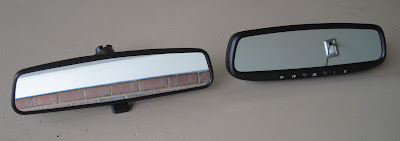When I bought StinkBug, the only bit still installed in the interior was the headliner. The headliner was a remnant of an early 90s aftermarket interior redo at the local upholstery shop in Virginia by the previous owner. A receipt with the car showed that the interior cost $2000 for parts and labor. (The headliner in 2015 was a mouse metropolis with poop and pee everywhere. Nasty.) The windlace was missing.
I had bought a "Ciadella" Bel Air interior kit in Black and Green from Eckler's when they were having a big sale last year. I got at least 20% off the cost of the kit, but with the extra seat belts, post boards, sail boards, and arm rests (pretty sure I bought those separately), the kit was close to $2000. Ouch.
There's a
Ciadella video online that shows some of a headliner install in a 2-door, but it glosses over the windlace install and doesn't mention the similar but different 4-door sedan. Not sure why they don't do a more comprehensive video series showing how to install their kits.
Here's how I installed mine. (I'm going to highlight some areas that were not covered in the video.)
 |
| The old headliner bows need to be kept in order, so number them. You also need to clean and paint them with a glossy paint (to let the headliner slide freely on them and to stop rust). |
|
|
At this point, you need to install all the windlace first -- as well as run any wiring into the dome light area and door jamb switches. I cleaned and painted the underside of the roof as well to remedy the evidence of mice and to stop surface rust over time. Mark the holes (top or bottom) where the headliner bows were previously installed, even if you are painting the roof. I painted over mine accidentally...
 |
| You can use an air stapler, but I had a manual one from 20 years ago in my tool box, so I used that. (Harbor Freight has a stapler with two-sizes of staples for only $10.) You need short staples and long ones. The short ones are for the leading edge of the headliner along the front windshield; the long ones are for the windlace. |
 |
| Here's the painted roof along with some strips of leftover Dynamat. The rear tangs are ready to accept the headliner board. The headliner will be inserted under the back glass gasket and the tangs tapped with a dead blow hammer to flatten them, securing the headliner. Note the windlace's toothed trim, that I cleaned and painted gloss white. It's unpainted from the factory and prone to rust. |
 |
| The toothed trim follows the contour of the door and is secured by screws. The windlace is held in place along the top by this trim. You need to staple the windlace along the corners -- and vertical runs at the front and back of the windlace only, not along the post boards. |
 |
| In this photo, you'll notice two areas where I deviated from stock. First, it appeared that Ciadella had pre-punched the holes in my post boards about and inch off. The only way the windlace would line up around the B pillar corners was to punch new holes. Second, I used plastic interior fasteners to tap the post boards up there securely. The factory uses metal tangs that are sometimes missing and can break easily all these decades later. I used duct tape to protect the slot in the front and rear windlace trim. |
 |
| The front windlace trim has a contour that needs to be fitted well around the opening. The front windshield trim will fit up against this piece and even attaches to it. The windlace trim screws are slotted to allow for lining up the trim. |
 |
| Here's the dome light plate with fresh wiring. Make sure these wires are installed correctly along the roof line, and easy to find for later fitment of the dome light assembly. |
Double check that the windlace will be lined up down near the dash and front foot well, and along the rear quarter. My next posts will highlight the vertical windlace runs.























































